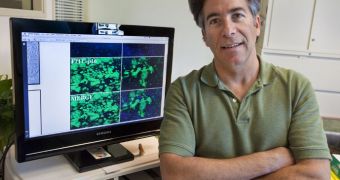One of the main mechanisms through which cells turn cancerous from external sources is exposure to ionizing radiation. This has been clearly established in extensive and thorough studies. The radiations were found to produce extensive genetic damage, as well as mutations, which increase the chance of cancer appearing. However, in a new study, researchers identified a new mechanism through which these factors act to promote cell damage. The team says that exposure to ionizing radiation affects the environment surrounding cells, opening the path for them turning cancerous in the future.
The work was conducted by scientists at the US Department of Energy’s (DOE) Lawrence Berkeley National Laboratory (Berkeley Lab), who analyzed the influence of these triggers on breast cancer cell cultures. “Our work shows that radiation can change the microenvironment of breast cells, and this in turn can allow the growth of abnormal cells with a long-lived phenotype that has a much greater potential to be cancerous,” explains Berkeley Lab Life Sciences Division cell biologist Paul Yaswen. He is also a breast cancer research specialist at the lab.
Details of the work appear in a paper entitled “Promotion of variant human mammary epithelial cell outgrowth by ionizing radiation: an agent-based model supported by in vitro studies,” which is published in the latest online issue of the esteemed scientific journal Breast Cancer Research. The paper, on which Yaswen was a corresponding author, was coauthored by Berkeley Lab investigators Rituparna Mukhopadhyay, Sylvain Costes, Alexey Bazarov, William Hines and Mary Helen Barcellos-Hoff.
“Many in the cancer research community, especially radiobiologists, have been slow to acknowledge and incorporate in their work the idea that cells in human tissues are not independent entities, but are highly communicative with each other and with their microenvironment. We provide new evidence that potential cancer agents and their effects must be evaluated at a systems level,” the team leader adds. The work lends additional credence to the theories proposing that cancer should be regarded as a condition taking place at a systemic level, rather than at the cellular one.
“The work we did was performed with non-lethal but fairly substantial doses of radiation, unlike what a woman would be exposed to during a routine mammogram. However, the levels of radiation involved in other procedures, such as CT scans or radiotherapy, do start to approach the levels used in our experiments and could represent sources of concern,” concludes Yaswen. He is also a Bay Area Breast Cancer and the Environment Research Center team member.

 14 DAY TRIAL //
14 DAY TRIAL //